Oxia Planum favoured for ExoMars surface mission
9 November 2018
The ExoMars Landing Site Selection Working Group has recommended Oxia Planum as the landing site for the ESA-Roscosmos rover and surface science platform that will launch to the Red Planet in 2020.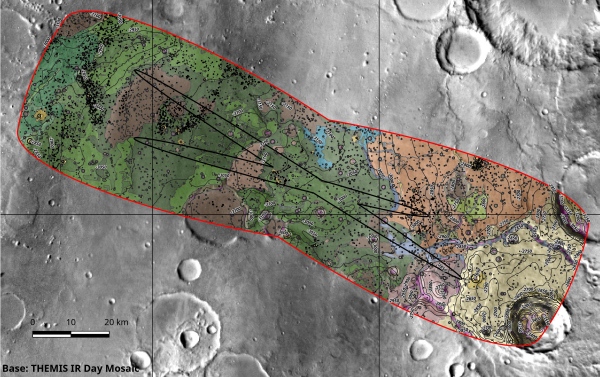 |
| Oxia Planum texture map. Credit: IRSPS/TAS; NASA/JPL-Caltech/Arizona State University |
The proposal will be reviewed internally by ESA and Roscosmos with an official confirmation expected mid-2019.
| ExoMars rover - a 360 degree view. Credit: ESA/ATG medialab. Click here for video details. |
At the heart of the ExoMars programme is the quest to determine if life has ever existed on Mars, a planet that has clearly hosted water in the past, but has a dry surface exposed to harsh radiation today.
While the ExoMars Trace Gas Orbiter, launched in 2016, began its science mission earlier this year to search for tiny amounts of gases in the atmosphere that might be linked to biological or geological activity, the rover will drive to different locations and drill down to two metres below the surface in search of clues for past life preserved underground. It will relay its data to Earth through the Trace Gas Orbiter.
 |
| Oxia Planum close up. Credit: NASA/JPL/University of Arizona |
Both landing site candidates – Oxia Planum and Mawrth Vallis – preserve a rich record of geological history from the planet's wetter past, approximately four billion years ago. They lie just north of the equator, with several hundred kilometres between them, in an area of the planet with many channels cutting through from the southern highlands to the northern lowlands. Since life as we know it on Earth requires liquid water, locations like these include many prime targets to search for clues that may help reveal the presence of past life on Mars.
"With ExoMars we are on a quest to find biosignatures. While both sites offer valuable scientific opportunities to explore ancient water-rich environments that could have been colonised by micro-organisms, Oxia Planum received the majority of votes," says ESA's ExoMars 2020 project scientist Jorge Vago.
"An impressive amount of work has gone into characterising the proposed sites, demonstrating that they meet the scientific requirements for the goals of the ExoMars mission. Mawrth Vallis is a scientifically unique site, but Oxia Planum offers an additional safety margin for entry, descent and landing, and for traversing the terrain to reach the scientifically interesting sites that have been identified from orbit."
The Landing Site Selection Working Group also emphasised that the discoveries generated during the landing site selection process are essential to guide the science operations of the ExoMars rover.
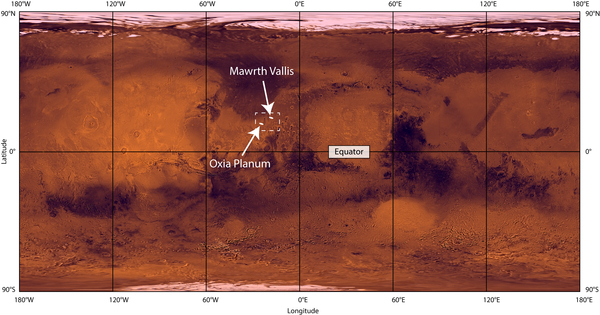 |
| ExoMars landing site candidates in context. Credit: NASA/JPL/USGS |
The recommendation was made today following a two-day meeting held at the National Space Centre in Leicester, UK, which saw experts from the Mars science community, industry, and ExoMars project present and discuss the scientific merits of the sites alongside the engineering and technical constraints.
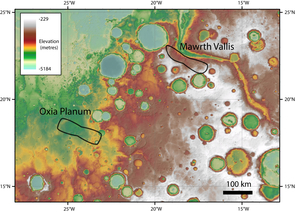 |
| ExoMars landing site candidates – elevation. Credit: NASA/JPL |
The quest to find the perfect landing site began almost five years ago, in December 2013, when the science community was asked to propose candidate locations. Eight proposals were considered in the following April, with four put forward for detailed analysis in late 2014. In October 2015, Oxia Planum was identified as one of the most compatible sites with the mission requirements – at that time with a 2018 launch date in mind – with a second option to be selected from Aram Dorsum and Mawrth Vallis. In March 2017, the down-selection identified Oxia Planum and Mawrth Vallis as the two candidates for the 2020 mission, with both undergoing a detailed evaluation over the last 18 months.
On the technical side, the landing site must be at a suitably low elevation level, so that there is sufficient atmosphere and time to help slow the landing module's parachute descent. Then, the 120 × 19 km landing ellipses should not contain features that could endanger the landing, the deployment of the surface platform ramps for the rover to exit, and the subsequent driving of the rover. This means scrutinising the region for steep slopes, loose material and large rocks.
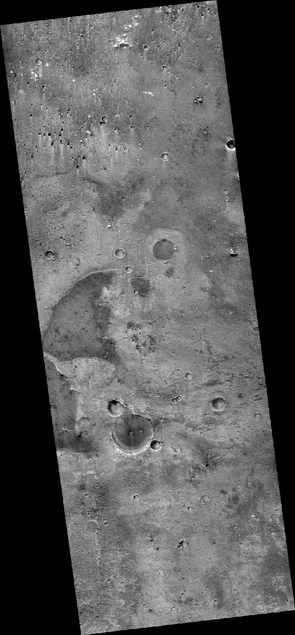 |
| A slice of Oxia Planum. Credit: NASA/JPL-Caltech/MSSS |
On the science side, the analysis had to identify sites where the rover could use its drill to retrieve samples from below the surface, and to define possible traverses it could make up to 5 km from its touchdown point in order to reach the maximum number of interesting locations.
Oxia Planum lies at the boundary where many channels emptied into the vast lowland plains. Observations from orbit show that the region exhibits layers of clay-rich minerals that were formed in wet conditions some four billion years ago, likely in a large body of standing water. The channels that transported material into the lower-elevation 'sink', where the landing ellipse is situated, cover an area of 212 000 square kilometres. Layers of material that have been recently exposed through erosion are accessible from any of the touchdown points, giving a window into the early history of this area.
The minerals in Oxia Planum are representative of those found in a wide area around the region and so would provide insight into the conditions experienced at a global scale, putting constraints on the climate and habitability potential of Mars in this period.
Diverse aqueous episodes were followed by late volcanic activity, covering over the clay-rich deposits. Some lava material has resisted erosion until today, so the underlying materials may only have been exposed recently, initially protecting them from space radiation and later making them accessible to the rover and its analytical tools.
The landing ellipse has low elevation and contains very few topographic obstacles or challenging slopes.
The ESA-led rover and Roscosmos-led surface science platform will launch in the 25 July–13 August 2020 launch window on a Proton-M rocket from Baikonur, Kazakhstan, and cruise to Mars in a carrier module containing a single descent module, arriving at Mars 19 March 2021.
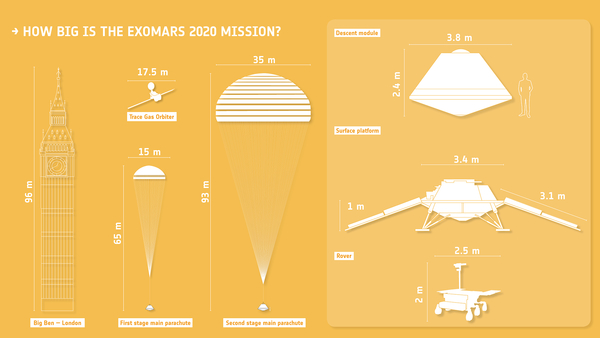 |
| How big is the ExoMars 2020 mission? Credit: ESA |
The descent module will separate from the carrier shortly before reaching the martian atmosphere, and will use two large parachutes, along with thrusters and a damping system, to slow its descent to land on the Red Planet. While the rover will drive to different locations to analyse the surface and subsurface, the stationary platform will provide context imaging at the landing site, and long-term climate monitoring and atmospheric investigations.
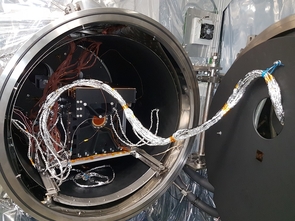 |
| Rover laboratory inside test chamber. Credit: TAS-I |
The test campaign for preparing the rover for Mars is in full swing. The rover structural and thermal model test campaign has been successfully completed, and a six-week qualification test on the Analytical Laboratory Drawer – the onboard laboratory where the rover's drill samples will be processed and analysed – is also nearing completion. The test included verifying the functionality of the sample processing mechanisms using Mars analogue samples under simulated Mars environment conditions – a low pressure, carbon dioxide atmosphere and a range of temperatures.
Tests to characterise the rover's ability to tackle different types of terrain are also ongoing with the locomotion verification model. The delivery of flight hardware has also started, including the rover's computer, battery and deployable mast, along with the majority of science instruments.
"Our ExoMars mission combines extreme performance with the novel design features of the rover, and we are looking forward to operating the first European mission on the surface of Mars," says Francois Spoto, ExoMars Programme team leader.
"Landing on Mars has a long chain of risks, but thanks to the combined skills and expertise of European and Russian industries working with reliable technologies, we are focused on a safe landing."
Notes for editors
More information about the Landing Site Selection Working Group is available here.
For further information, please contact:
Jorge Vago
ESA ExoMars 2020 project scientist
Tel: +31 71 565 5211
Mob: +31 6 27 65 87 70
Email: jorge.vago![]() esa.int
esa.int
Francois Spoto
ESA ExoMars Programme team leader
Tel: +31 71 565 4509
Mob: +31 6 52 06 21 62
Email: francois.spoto![]() esa.int
esa.int
Markus Bauer
ESA Science and Robotic Exploration Communication Officer
Tel: +31 71 565 6799
Mob: +31 61 594 3 954
Email: markus.bauer![]() esa.int
esa.int








